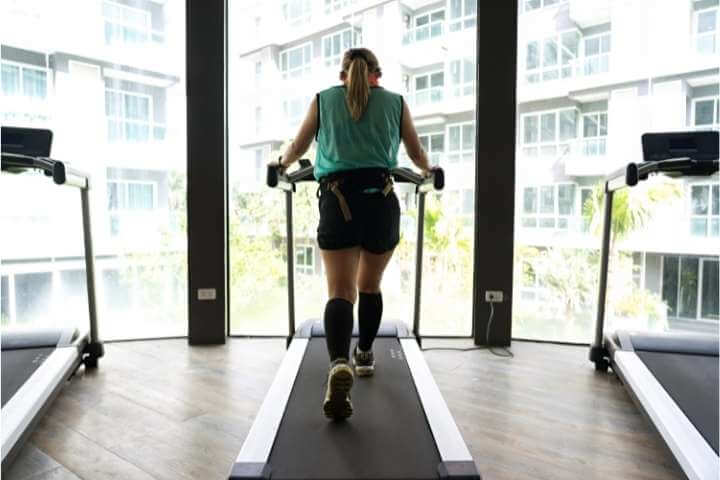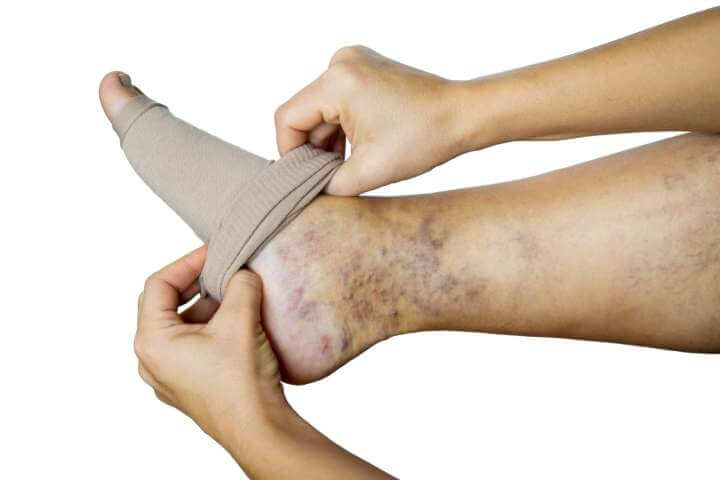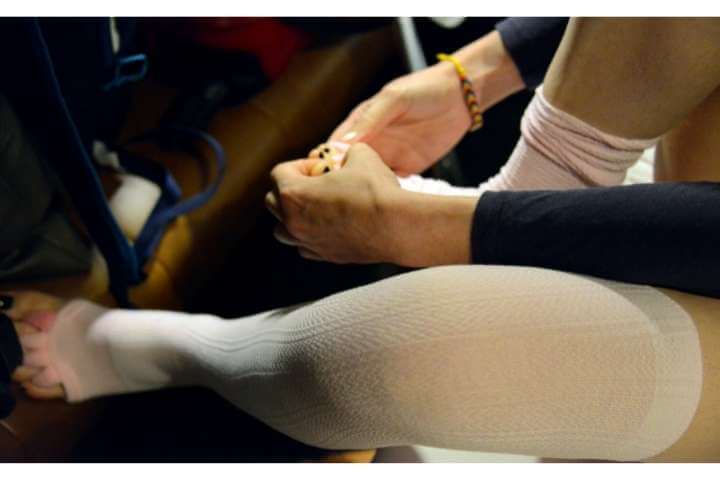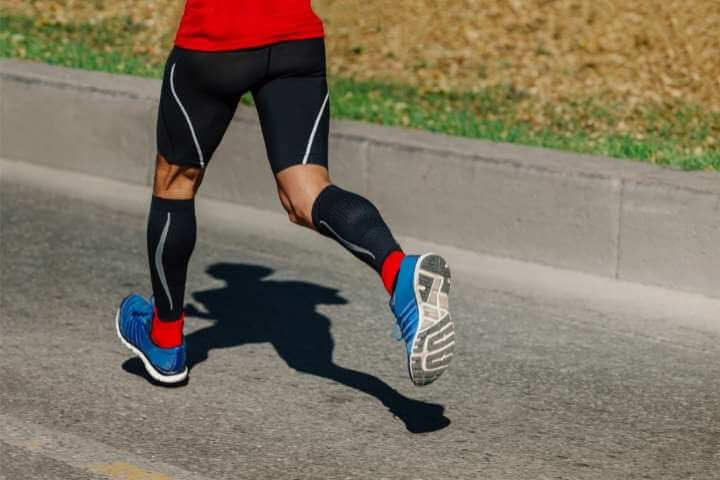Restless leg syndrome is a condition that causes our legs to move uncontrollably or twitch when we don’t want them to. Most people feel the symptoms the worst at night when they’re trying to fall asleep, and they have the urge to get up and move around.

Moving around will usually provide temporary relief, but as soon as they lay back down to try and sleep their legs start to move again.
While there hasn’t been a direct cause found for restless leg syndrome, it has been found that one in five people who have this condition also have a vein disease.
Many people with vein conditions have found that compression socks help give them relief from the symptoms they experience, so it the question as to whether they can be used for restless leg syndrome is pretty reasonable.
The short answer? Yes – compression socks can help with some of the symptoms of restless leg syndrome.
Restless leg syndrome and vein conditions
Some vein diseases have been seen as the springboard into having restless leg syndrome, as they can share similar symptoms.
The two conditions that are closest to restless leg syndrome are varicose veins venous insufficiency. There are some medical professionals who believe that there are strong connections between these two conditions and people developing restless leg syndrome.

In fact, when people see a doctor for symptoms of restless legs their doctor will also usually examine them for a vein disease to see if there is something else going on.
If someone has a vein disease that is the underlying cause of restless leg syndrome – which it often is – the vein disease has to be identified and treated (if possible) before they get relief from the symptoms of restless leg syndrome.
Many doctors will recommend compression socks for alleviating the symptoms of many vein diseases, and they can actually help with the symptoms of restless leg syndrome.
What is compression gear?
This type of clothing is an elastic type of material. The piece of clothing, socks for example, will apply pressure to the legs and ankles while you’re wearing them.
This pressure help the veins valves, and ensures they are functioning properly to send blood back and forth to the heart without any obstructions.
This increased blood circulation helps to prevent medical conditions like spider veins, varicose veins or venous insufficiency.
Some people wear compression socks every day, and some people only wear them when their conditions are really bothering them or they notice the symptoms are worse.
When putting these socks on, you have to put them on in the morning before you lower your legs to get out of bed.
Different types of compression wear
There are varying levels of compression socks that can be purchased, and you will have to determine what is the right option for you based on the severity of the symptoms you are experiencing.
The different types of socks have different levels of compression, and it’s important you choose the right amount of compression for you.
Mild compression
If you have very mild symptoms of restless leg syndrome, it’s usually enough to have just a slight amount of pressure applied to your legs to keep a healthy blood flow.
If this is the right amount of compression for you, your legs will start to feel lighter and you won’t have the tingling or painful feeling so you’ll start to feel better.
Moderate compression
This level of compression sock is helpful for those times when your symptoms are a little more severe, or if your restless leg syndrome has escalated.
Depending on the type of symptoms you experience, you may want to keep a couple different levels of compression in your home.
Firm and extra-firm compression
This is for people who experience extreme symptoms of restless leg syndrome and there is very little that offers them relief.

For people who have other medical issues dealing with their veins, having restless leg syndrome on top of that may cause more pain that is hard to deal with.
Restless leg syndrome and compression wear
If you’re looking for advice on what kind of compression wear or compression socks to purchase for helping with the symptoms of restless leg syndrome, your doctor can help advise as to which would work best for you.
There are many benefits for those who have restless leg syndrome to invest in some compression socks to help alleviate their symptoms.
If you are in situations where you experience prolonged sitting or standing, long car rides or even are pregnant these can really help.
They don’t have to be worn all the time either – you can wear them on days when the symptoms feel especially bad to help give you some relief.
Compression socks can help to alleviate symptoms like
- Leg cramping at night
- Tingling and pain experienced with restless leg syndrome
- The urge to get up and walk around at night
- General fatigue in your legs
How to pick the right compression socks for you
Just like any other item of clothing, when you’re making a purchase you want to make sure that what you buy is going to fit you properly and is going to be comfortable for you to wear.
If you’ve decided to give compression socks a try to help get some relief from your symptoms of restless leg syndrome, you’ll need to measure to make sure you get the right fit before buying.
Here are a few tips you might find helpful when measuring to find the right size fit of compression socks for you.
- Measure your leg (lower leg) before you get out of bed in the morning – this is when it’s probably going to be the smallest and least swollen (if you experience any kind of swelling of your ankles).
- If you’re going to buy the stockings, measure starting at the narrowest part of your ankle and then work your way up to the widest part of your calf. Next, sit up and place your feet on the floor making a 90-degree angle with your knee and measure from the bent kneed to the floor for each of your legs.
- If you are going with the thigh-high stockings you will need to repeat this last step, followed by measuring from your thighs to the floor standing up. Finally, you’ll need to measure between your buttocks and the floor.
Many medical professionals believe that compression socks help a great deal when it comes to providing relief from the symptoms of restless leg syndrome.
Are compression socks covered by insurance?
The answer to this question really depends on the kind of insurance you have, and if the compression socks have been prescribed by a doctor.
Before looking to buy these, you can always reach out to your insurance company to see if you have coverage for purchasing these. Many private insurance or extended benefits give some coverage for this type of help, but you may need to get a pre-determination of coverage.
Talk to you doctor about the difference to see if you can get them prescribed to you and then get them covered under your insurance.
Compression socks vs. massaging your legs
It’s been recommended for those who have restless leg syndrome that massaging their legs can really help to alleviate the symptoms they are experiencing.
Massaging your legs helps to increase the blood flow to the legs, and with improved circulation the overstimulated nerves will relax and the tension will release.
Wearing compression socks is like having that pressure from a massage applied to your legs at all times when you’re wearing them. Applying constant pressure can really help with the symptoms you’re experiencing, and you don’t have to sit and massage your legs to get relief.
So it’s really up to you if you prefer to use massage, or a massage gun, or wearing compression socks during the day to make sure you keep circulation going to your legs.
You could choose to only wear the compression socks when your symptoms are at their worst, especially if you only have a mild form of restless leg syndrome.

Final thoughts
There is no one treatment that will alleviate the symptoms of restless leg syndrome for everyone – it might be a series of trial and error to find what works for you and gives you relief from pain.
Making a purchase to have compression socks on hand for those days when your legs are really bugging you might be worth the investment for you.
For people who have a more severe form of restless leg syndrome, they may need the extra-firm compression to apply more pressure to their legs.
While those who only have mild symptoms may only need light compression, and might only need to wear them once in a while.
If you think that compression socks will work for you, and help give you relief, make an appointment to chat with your doctor and see how they can help you to get some relief from the aches of restless leg syndrome.
